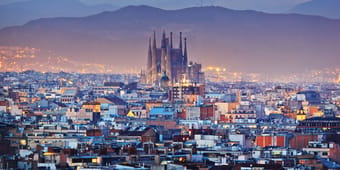
Flights to Barcelona with Air France from ZAR 11,209*
expand_more
1 Passenger, Economy
expand_moretoday
today
*Modifying this information may result in a different fare
Find your flight to Barcelona
flight_takeoff
flight_land

Johannesburg (JNB)to
Barcelona (BCN)03/10/2026 - 03/31/2026
From
ZAR 11,209
Seen: 8 hrs ago
Round-trip
Economy

Johannesburg (JNB)to
Barcelona (BCN)03/17/2026 - 03/31/2026
From
ZAR 11,209
Seen: 8 hrs ago
Round-trip
Economy

Johannesburg (JNB)to
Barcelona (BCN)02/16/2026 - 03/16/2026
From
ZAR 11,223
Seen: 5 hrs ago
Round-trip
Economy

Johannesburg (JNB)to
Barcelona (BCN)02/18/2026 - 02/25/2026
From
ZAR 11,223
Seen: 5 hrs ago
Round-trip
Economy

Johannesburg (JNB)to
Barcelona (BCN)02/15/2026 - 03/01/2026
From
ZAR 11,223
Seen: 5 hrs ago
Round-trip
Economy
*Fares displayed have been collected within the last 48hrs and may no longer be available at time of booking. Additional fees and charges for optional products and services may apply.
Check our flights to Barcelona for the upcoming months
flight_takeoff
flight_land
From | To | Fare Type | Dates | Price |
|---|---|---|---|---|
| Johannesburg (JNB) | Barcelona (BCN) | Round-trip / Economy | 03/10/2026 - 03/31/2026 | From ZAR 11,209 Seen: 8 hrs ago |
| Johannesburg (JNB) | Barcelona (BCN) | Round-trip / Economy | 03/17/2026 - 03/31/2026 | From ZAR 11,209 Seen: 8 hrs ago |
| Johannesburg (JNB) | Barcelona (BCN) | Round-trip / Economy | 02/16/2026 - 03/16/2026 | From ZAR 11,223 Seen: 5 hrs ago |
| Johannesburg (JNB) | Barcelona (BCN) | Round-trip / Economy | 02/18/2026 - 02/25/2026 | From ZAR 11,223 Seen: 5 hrs ago |
| Johannesburg (JNB) | Barcelona (BCN) | Round-trip / Economy | 02/15/2026 - 03/01/2026 | From ZAR 11,223 Seen: 5 hrs ago |
*Fares displayed have been collected within the last 48hrs and may no longer be available at time of booking. Additional fees and charges for optional products and services may apply.

Travel to Barcelona
Whether you're looking for a last-minute Barcelona (BCN) flight or planning a flight at a later date, take advantage of our lowest prices for your travel dates on this site. With our flights list you can easily find for the coming months the cheapest prices to fly with Air France to Barcelona (BCN). You can also directly pick your departure date on our booking engine at the top of the page, if your trip to Barcelona (BCN) is already scheduled.
Barcelona - the metropolis on the Mediterranean that takes you on a journey through time
Barcelona is one of western Europe's oldest cities. Its origins are uncertain, but the site was certainly occupied by the Romans around 15 BC. The city subsequently fell under the control of the Visigoths, the Arabs and the Crown of Aragon before becoming a part of Spain. The region's Mediterranean climate makes it a great holiday destination at any time of year, and great-value airline tickets are available on daily flights from Johannesburg or Cape Town to Barcelona via Paris and Amsterdam. Journey times start at 14 hours, including connecting flights. This city of some 1.6 million people has a very distinctive identity, which is exhibited in various ways, the most obvious being the use of Catalan as the language of local government. Most Barcelona residents will speak both Catalan and Spanish. As you'd expect in a city of Barcelona's size, there is a wide range of accommodation options. The local currency is the euro and Barcelona, being part of Spain, lies within the Schengen Area - check out the travel documents section on the Air France website for more details. The city was widely-judged to have been transformed by the large-scale refurbishment of the urban infrastructure and fabric that preceded the 1992 Summer Olympics and by the boost the Games provided to Barcelona's international profile. Barcelona's main artery, Las Ramblas, is located in the heart of the Ciutat Vella, or Old Town.
Other key districts include:
- Gràcia
- Eixample
- Sants-Montjuïc
- Sant Martí
Eixample is especially renowned for its modernist, Art Nouveau buildings and the still unfinished church of the Sagrada Familia. Widely acclaimed as Antoni Gaudí's masterpiece, construction is scheduled to be completed by 2026, in time for the 100th anniversary of Gaudí's death. The city is served by Barcelona El Prat airport, which is located just 12 km from the city centre.
Barcelona - travel to a city at the cutting-edge of urban design
Barcelona has long blazed a trail for others to follow in the field of urban architecture. Gaudí's remarkable town houses like the Palau Güell, Casa Milà and Casa Batlló, Park Güell and the stunning Palau de la Música Catalana by Lluís Domènech i Montaner are some of the best-known representatives of the Catalan 'modernista' style. The Palau de la Música Catalana continues in use as a concert venue today, offering performances for lovers of classical music, jazz and Cançó (Catalan singing). Other architectural marvels in the city include the replica of the Barcelona Pavilion designed by Ludwig Mies van der Rohe and built in 1929, and the monumental Nou Camp, home to FC Barcelona and the largest stadium in Europe, with a capacity of 99,786 people.
Like all cities in Spain, Barcelona wouldn't be Barcelona without its festivals. Perhaps the most interesting are those with strong local roots, such as La Mercè (September 24th). This is the city of Barcelona's own festival, with highlights including a parade of outsize papier-mâché figures, firework displays at Montjuïc and the stunning feats of agility performed by the Castellers. These are teams of people who carry on an 18th century Catalan tradition of building 'human towers' that can rise up to ten 'levels' high, in other words, the height of ten people standing on one another's shoulders. If that all sounds like too much hard work, don't forget that Barcelona is also something of a beach resort! The city boasts a total of seven beaches extending along a 3 mile-long stretch of coastline.
